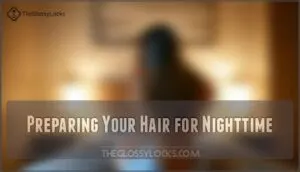This site is supported by our readers. We may earn a commission, at no cost to you, if you purchase through links.

Apply a lightweight moisturizer or oil to keep your locks hydrated.
Choose a satin or silk scarf or bonnet—they’re softer than cotton and help reduce friction and frizz.
For straight styles, smooth your hair around your head like a crown before securing it with the scarf.
If you have curls, tuck them into the bonnet to maintain their shape.
Consistency is key, and your hair will thank you in the long run.
Curious about protecting hair without a wrap?
There are smart alternatives!
This approach will help with frizz.
Table Of Contents
- Key Takeaways
- Preparing Your Hair for Nighttime
- Securing Your Hair Wrap
- Maintaining Hair Health While You Sleep
- Frequently Asked Questions (FAQs)
- How to wrap your hair for sleeping?
- How to wrap short hair and tuck it in at night?
- Why should you wrap your hair to sleep at night?
- How do you Wrap Your Hair?
- Is it better to sleep with your hair open or tied?
- How do you prevent hair wrap slippage?
- Can hair wrapping help with scalp health?
- How often should hair wraps be washed?
- What hairstyles work best under wraps?
- Are hair wraps suitable for all hair types?
- Conclusion
Key Takeaways
- Detangle your hair and apply a lightweight moisturizer or oil before wrapping to lock in moisture and prevent breakage.
- Use a silk or satin scarf or bonnet to reduce friction, retain moisture, and protect against frizz overnight.
- Secure your wrap snugly to prevent slippage and maintain your hairstyle, using bobby pins or elastic headbands if needed.
- Opt for protective styles like braids, twists, or buns under wraps to keep your hair tangle-free and well-maintained.
Preparing Your Hair for Nighttime

Getting your hair ready for bedtime sets the stage for healthier, smoother locks by morning.
Start by detangling thoroughly and adding a lightweight moisturizer to keep your strands hydrated and manageable.
Detangling and Moisturizing
Detangling and moisturizing are the key steps to priming your hair for overnight hydration. Start with gentle hair detangling using a wide-tooth comb or fingers. Next, lock in moisture by applying a leave-in conditioner or hair oil for effective product absorption.
Detangle with care and hydrate deeply to wake up to smoother, healthier hair that shines with moisture and vitality.
Don’t forget your scalp—it craves care, too. A light scalp massage with oil promotes healthy circulation and reduces dryness. For added protection, consider protective styling options.
Before bed, prepare with these essentials:
- Wide-tooth comb for frizz reduction
- Leave-in conditioner for overnight treatments
- Hair oil for moisture
- Scalp massage for overall scalp health
Choosing The Right Hair Wrap Material
After nourishing your hair, focus on selecting the right hair wrapping materials.
Silk scarves and satin bonnets are go-to options, thanks to their breathability and fabric durability.
Silk works for all hair textures, while satin offers a more affordable alternative.
Consider environmental impact—cotton’s biodegradable but absorbs moisture.
Many people shop for a quality silk product to protect their hair.
Prioritize material choice that preserves moisture overnight for smooth, healthy locks, using materials that support healthy locks.
Securing Your Hair Wrap
Securing your hair wrap properly guarantees it stays in place and protects your hair overnight.
Use the right technique and materials to keep your hair smooth, healthy, and free of frizz by morning.
Using Satin or Silk Scarves

Securing your hair with a silk or satin scarf at night is a simple but powerful step to protect your locks. Silk scarf wrapping feels luxurious, offering superior softness and reducing breakage, while satin scarves or bonnets give similar benefits with easier care.
Pay attention to the scarf’s size, as it should cover all your hair securely. Opt for high-quality materials to avoid rough edges that can cause frizz. Many people prefer a satin hair bonnet for its ease of use.
- Preserve moisture without absorbing natural oils.
- Minimize friction, preventing split ends.
- Bring style and comfort with diverse prints.
- Choose durable designs for long-term use.
- Ensure even coverage for complete protection.
Tips for Using Bonnets and Snap-on Rollers
For proper night hair care, bonnets and snap-on rollers are game-changers.
They protect hair overnight, prevent hair breakage, and keep your look intact, making them essential for effective overnight hair protection.
Choose a bonnet material like satin or silk to protect hair overnight, reduce friction, and lock in moisture.
The secure fit matters—snug enough to stay in place but comfortable for overnight comfort without marks or headaches.
Snap-on rollers enhance hairstyling versatility; match roller size to your hairstyle suitability, like smaller rollers for tighter curls or larger ones for waves.
Together, these tools protect hair overnight, prevent hair breakage, and keep your look intact.
These bonnets also carry cultural expression significance, especially for Black women, highlighting their importance beyond just hair care.
Maintaining Hair Health While You Sleep
Protecting your hair while you sleep is key to keeping it smooth and frizz-free. With the right techniques and materials, you can wake up to healthier, well-maintained locks every morning.
Benefits of Silk and Satin
Silk and satin wraps are game-changers for night hair care.
Silk, a natural fiber, helps with frizz reduction and moisture retention by minimizing friction, while satin offers a budget-friendly alternative that prevents breakage and keeps curls hydrated.
Silk reduces frizz and locks in moisture overnight, while satin offers affordable protection for smooth, hydrated mornings.
Both materials act like a soft shield, preserving your style overnight and protecting against dryness caused by cotton pillowcases.
Silk proteins add strength by boosting keratin production.
Choosing a silk wrap or satin wrap isn’t just about luxury—it’s about giving your hair the care it deserves for smoother, healthier mornings.
Alternatives to Traditional Hair Wraps
Looking for fresh ways to protect your hair while you sleep? Try these alternatives to traditional wraps for sleek, healthy strands:
- Slap Caps: These satin-lined caps are stylish and perfect for locking in moisture without the fuss of tying.
- Hair Buffs: Lightweight and stretchy, buffs gently hold your hair in place without tugging, ideal for braided or curly styles.
- Satin Pillowcases: Skip wrapping altogether and opt for a smooth satin pillowcase to minimize friction and frizz.
Consider stylish satin options for overnight protection.
For extra protection, add a shower cap over conditioning treatments or secure buns with silicon ties. These simple swaps keep your sleep routine stress-free yet effective!
Styling Tips for Post-wrap Hair
When you unwrap your hair in the morning, it’s like revealing the results of your hair wrapping care.
Start by gently shaking your roots to revive volume and lift. For curls, scrunch them lightly with your hands to bring back definition and shine.
Run your fingers through your hair to adjust parting perfection effortlessly. If frizz appears, a spritz of water or lightweight leave-in conditioner can work wonders. Treat your strands gently, like handling a delicate fabric, to avoid breakage.
For a polished look, skip heavy heat styling. Use a diffuser on low for quick touch-ups or a flat iron with minimal heat for straightened styles. Keeping your routine simple guarantees style preservation and promotes healthy locks. By focusing on hair styling tips that enhance shine and control, you’ll keep your hairstyles vibrant and reduce morning stress.
Frequently Asked Questions (FAQs)
How to wrap your hair for sleeping?
Brush your hair to remove tangles, then wrap it snugly around your head.
Secure with bobby pins or a silk scarf.
For curly styles, use a satin bonnet to maintain shape and reduce friction.
How to wrap short hair and tuck it in at night?
Think of short hair as petals, gently folding them inward.
Start by brushing to detangle, then wrap sections around your head and secure with bobby pins.
A satin or silk scarf keeps everything tucked neatly overnight. **
Why should you wrap your hair to sleep at night?
Wrapping your hair at night protects it from tangles, frizz, and breakage while locking in moisture.
It keeps hairstyles intact, reduces friction against pillows, and promotes healthier strands, so you wake up with manageable, nourished hair.
How do you Wrap Your Hair?
Wrapping your hair is like tucking it into a cozy blanket.
Start with detangled, dry strands. Gather sections, smooth them around your head, secure with bobby pins,
and cover with a silk or satin scarf.
Is it better to sleep with your hair open or tied?
It’s better to sleep with your hair tied loosely using silk or satin materials.
This minimizes tangles, reduces breakage, and preserves moisture overnight.
Sleeping with hair open increases friction, causing potential damage and frizz.
How do you prevent hair wrap slippage?
To keep your hair wrap secure, use a silk or satin scarf, tie it snugly (not too tight), and consider adding an elastic headband around it.
Opting for a high-quality material reduces slippage substantially.
Can hair wrapping help with scalp health?
Yes, wrapping your hair can improve scalp health by locking in natural oils and moisture, reducing dryness, and minimizing friction.
It helps soothe your scalp overnight while protecting hair from breakage and damage.
How often should hair wraps be washed?
Think of hair wraps like your favorite outfit—they need regular care.
Wash them weekly if used daily, or every two weeks for lighter use.
This prevents oil buildup and keeps your hair fresh and clean.
What hairstyles work best under wraps?
Braids, twists, or sleek buns are perfect under wraps, keeping your hair tangle-free and moisturized.
Protective styles like bantu knots or flat twists work great too, preserving your look while reducing friction and breakage, which makes them a great option for hair care, and they can be considered as protective styles.
Are hair wraps suitable for all hair types?
Hair wraps suit all hair types, acting like a shield for your strands overnight.
Whether your hair’s curly, straight, or textured, wrapping prevents frizz, retains moisture, and protects styles.
Just choose materials suited to your needs!
Conclusion
Did you know that wrapping your hair at night can reduce breakage by up to 43%?
By learning how to wrap your hair at night, you’re protecting it from dryness, frizz, and damage caused by friction.
The right materials, like satin or silk, paired with proper preparation, guarantee your hair stays smooth and healthy.
Whether you prefer scarves, bonnets, or alternative methods, consistency is key. Stick with it, and your hair will thank you with healthier, frizz-free mornings.







